
Our travel trailer came with the typical, not very good, holding tank monitor system.
RV manufacturers install holding tank monitor systems, built by a handful of different vendors, but most don’t work well.
With ours, the Fresh Water Tank was always accurate, the Grey Water usually okay, and the Black Water tank very hit and miss. Normally, I could guess how much was in the Black Tank, by comparing the fresh water remaining, versus the level of the grey.
Given we often camp for a couple of weeks at a time in remote places, it is important for us to know how much water we have, and how much waste water is in the Black and the Grey Water tanks. If one gets full, and we are not ready to go home, we might have to drive 100 miles to find a sanitary dump station.
Anyway the Fresh Water readings went bonkers on our monitor panel. Time to diagnose.
But first, a conversation about RV maintenance.
Some Thoughts on RV Maintenance and Repair
If you are a regular reader of my blog, you have probably noticed a lot of posts about maintenance/repair issues.
The fact is RVs aren’t as well built as we might hope. Even the high end RVs require constant maintenance and the occasional repair. Keep in mind that all manufacturers buy components from the same few third party vendors. For the “do it yourself” crowd this might be a good thing, as replacement parts are typically easy to get.
Plus, keep in mind, manufacturers are going offshore more and more for the lowest cost possible.
If an RV owner isn’t handy or willing to pay someone to do the required maintenance or repairs, then a RV might not be a good thing to purchase. I wrote about renting an RV a while back as a good option.
Even if one is willing to pay to have these things done, most RV repair shops (independents and RV dealers) are very busy. Not unusual to have to drop your RV off for a few days or even weeks for even the simplest of required work.
I can do just about all the work myself, and for the most part, enjoy it. But I am getting older, recently turning 71 years young. It is time to repack the wheel bearings on our trailer and I am contemplating paying someone to do it for me. Yes, I can still do this kind of work, but I am getting slower and becoming more inclined to pay someone for some of these maintenance tasks.
Anyway, back to monitor problem.
The Problem
All of a sudden the fresh water tank reading would go from Full to 1/3 full. It would just skip the 2/3 full mark.
I would think we might think the Fresh Water tank was maybe 70% full, then suddenly it would show 33% full.
First thought was there was a connection problem to the 2/3 Full sensor. There was, but first a explanation on how these systems work.
RV Tank Monitor Systems Explained

Our system has four sensors in each tank.
Actually we have two Fresh Water tanks, and only one has sensors. Since the two tanks are connected, each tank has the same level as we use water, so only one of them needs sensors.
Each of the sensors sends information to the monitor panel if it is covered by water (fresh, grey or black water). One problem with this system is if residue sticks to a sensor, it will report it is covered, when in fact the level is below the sensor. This requires constant attention to cleaning the Grey, and especially the Black, tanks. This is done by adding chemicals to the tanks to clean the sensors.
I put together a few visuals to explain these. They aren’t super accurate, but show how our system works.
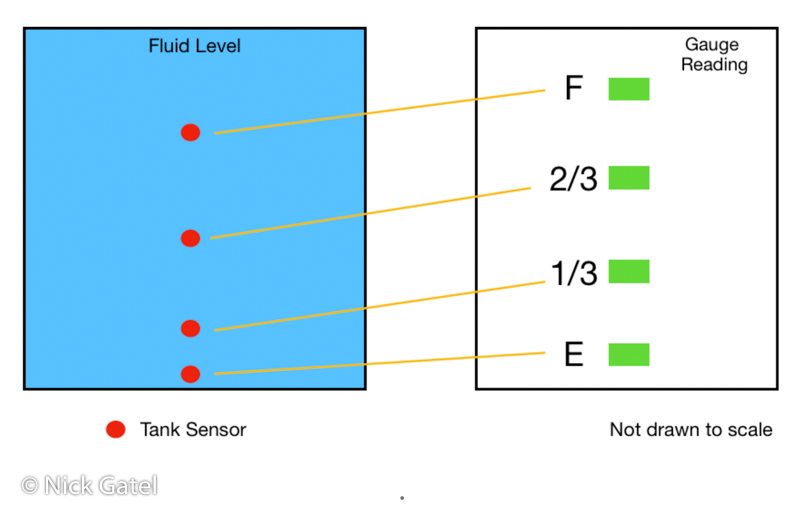
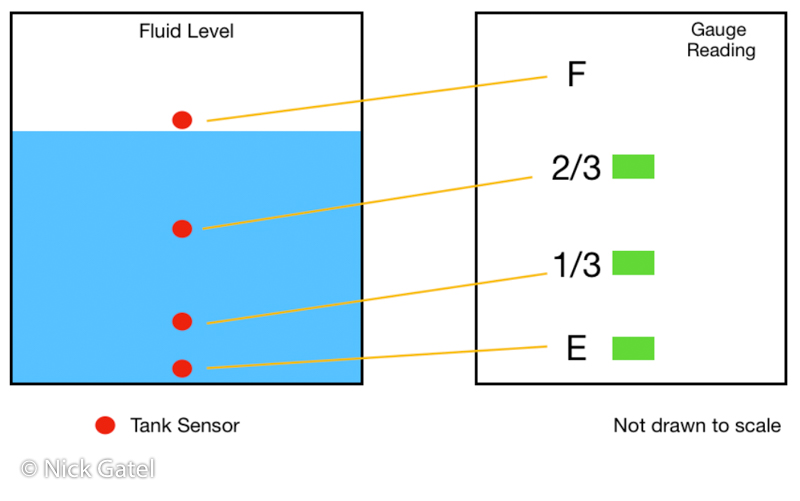
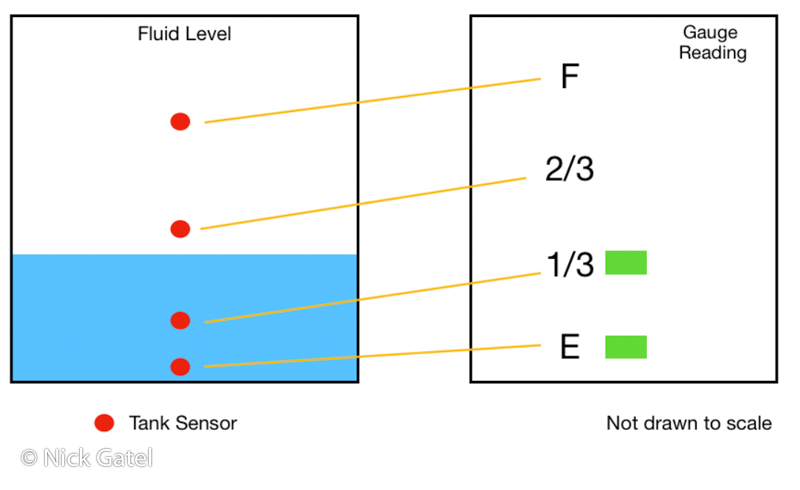
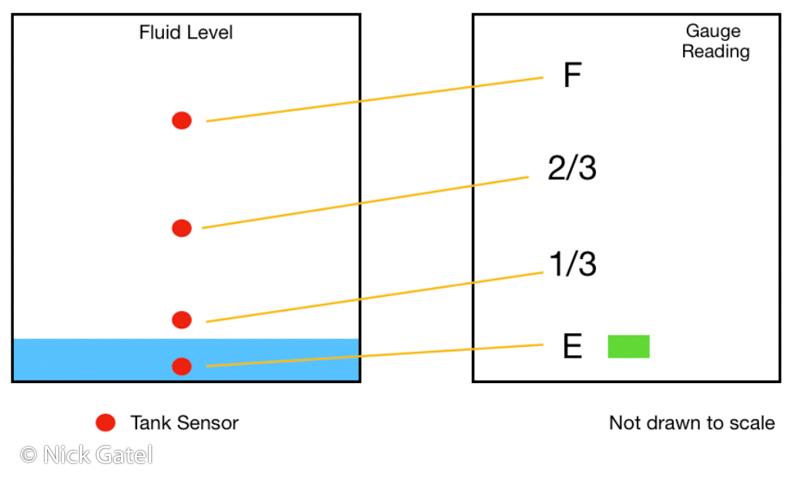
Our Sensors
These are simple well nuts.
A well nut is a neoprene busing with a nut at the narrow end. A hole is drilled in the material to be fastened so the narrow part of the busing barely fits. The bushing is inserted into the hole.
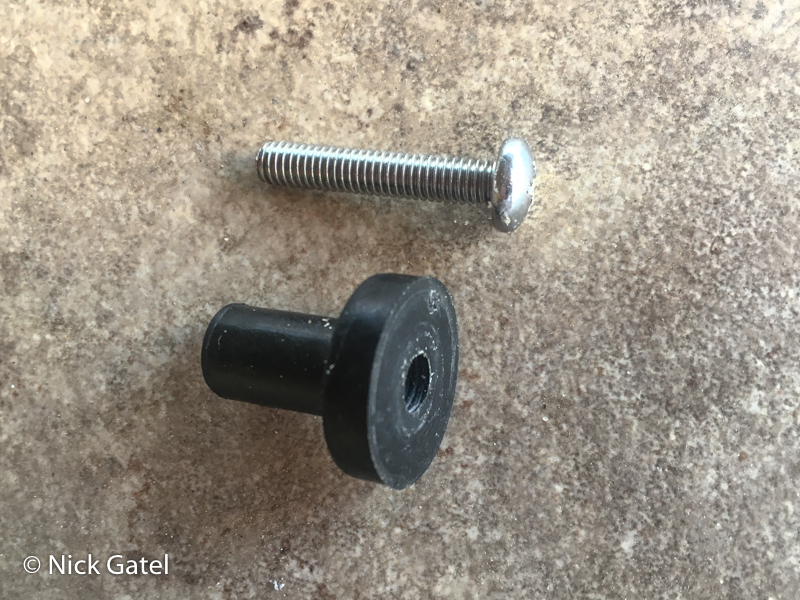
The fastener, in our case a screw) is insert into the wide part of the bushing and tightened. As the fastener is tightened, the bushing is compressed (squashed) so it forms a wide surface on the inside of the surface (the tank in this case). They are fairly well sealed, but it is always best to seal the outside of the bushing with silicone or other sealant.
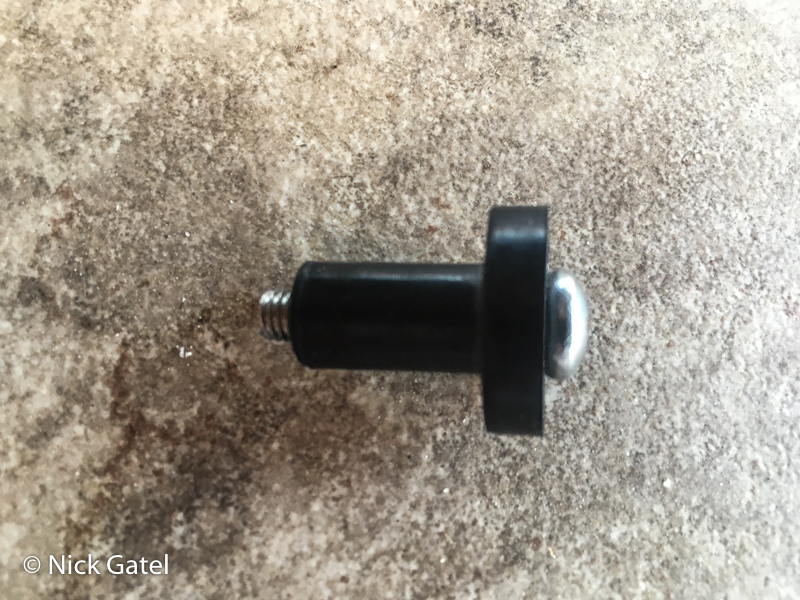
Well nuts can be incredibly useful when one needs to securely attached something to a flat surface, but there isn’t any access to the backside of the surface. I used well nuts to attach the solar panels on our current travel trailer.
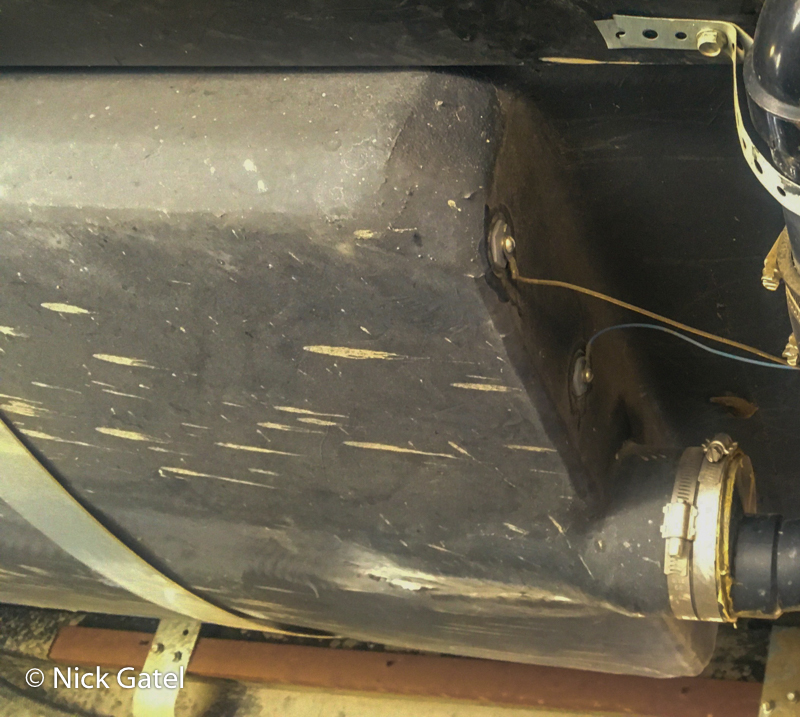 The image above shows the Empty sensor (tan wire) and the 1/3 Full sensor (blue wire). As I stated earlier, it is a simple system. What would be best is some sort of a float (like a car gas tank), but that would be expensive and would probably get gummed up from the contents of the Black and Grey tanks.
The image above shows the Empty sensor (tan wire) and the 1/3 Full sensor (blue wire). As I stated earlier, it is a simple system. What would be best is some sort of a float (like a car gas tank), but that would be expensive and would probably get gummed up from the contents of the Black and Grey tanks.
The sensors for our tanks use stainless steel screws so they won’t rust. But if residue from the Black or Grey water sticks to the end of a screw, the monitor panel will think it is covered by fluid. This causes a lot of inaccuracies, so one has to constantly add cleaning solutions to both the Black and Grey water tanks. Cleaning is only temporary, especially with the Black tanks.
I have bought a tank new cleaner chemical that looks promising, but I’ll wait to see how it actually works over time before sharing.
What I found
The 2/3 full sensor wire had come loose and was laying on the frame of the trailer. A concern was this wire had been touching electrical ground (the frame) and might have damaged the electronics in the monitor panel.
I connected the wire and tested the system. My fears being valid, the Fresh Water Panel still wasn’t working. Time to search the Internet.
A Better Option?
For few years I have been thinking about getting a Garnet SeeLevel Tank Monitor. It is much more accurate and the sensors are mounted outside the tank. However, if a tank gets a lot of sludge build up inside, they loose accuracy, so tank cleaning is still required, although much less often. The product generally has good reviews and is made in Canada.
However, as is often the case, we were getting ready to leave on a trip in a few days. I needed something quick and easy, and the SeeLevel II does take some time to install and calibrate. So my best option was to see if I could find a replacement panel.
An Internet Search
Looking at the old monitor, it appeared it was an Eclipse Micro Monitor. But I couldn’t find anything.

Then it dawned on me, Eclipse is the manufacturer of our trailer, and the “Eclipse” on the unit is the logo for Eclipse Recreational Vehicles, Inc. So obviously the vendor printed the logo on the unit for the trailer manufacturer.
Further research found this unit is made by a privately owned company in Santa Ana, California, JRV Products. Unfortunately they don’t sell direct to the public. But Amazon sells the whole kit with wires sensors, and the panel. I couldn’t locate just the panel anywhere.
So I ordered it and received it in 5 days.
The kit came with everything to do a complete new install. Sensors, wiring, circuit board and panel, and the mounting bezel.
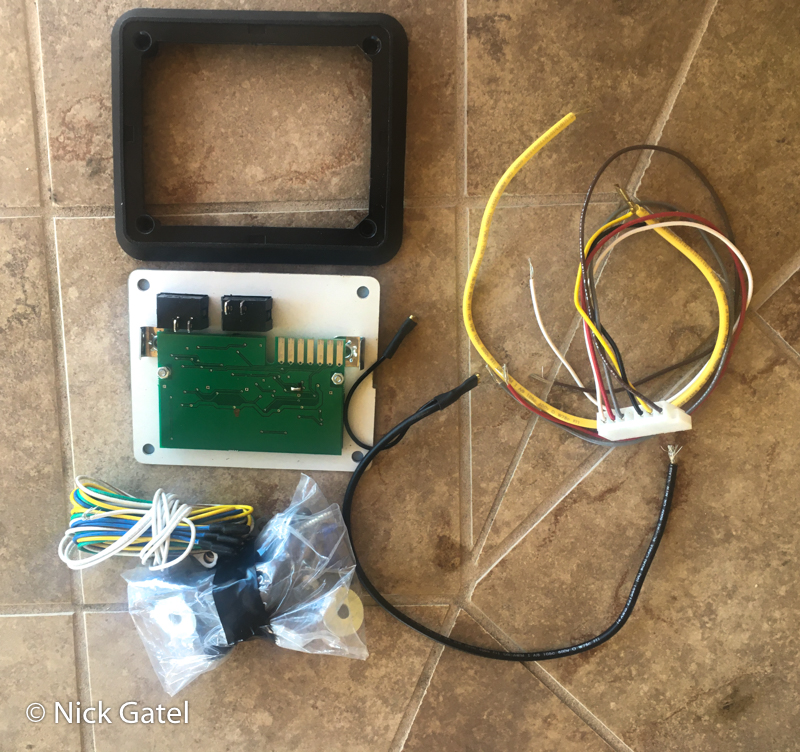
All I had to do was remove the panel from the bezel, transfer the wiring connections, and snap the new panel back into place.
It was interesting that the old panel circuit board would not plug into the new wiring loom connector, but the new circuit board did connect to the old connector. Just a function of how the board cut-outs work. Basically designed so the circuit board cannot be plugged in upside down.
Even the power connector for our water pump matched, since the water pump is turned on via the panel.
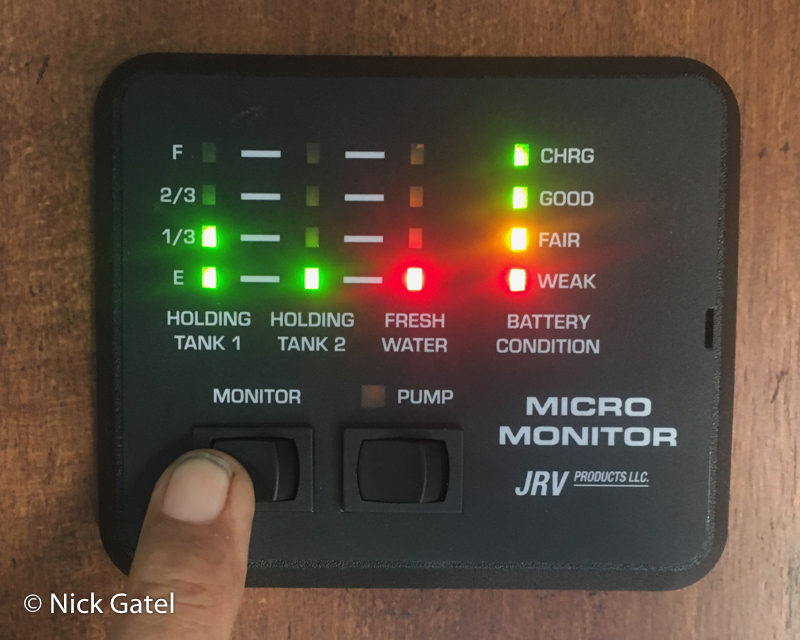
Everything works now.
Update July 2023: After 18 months the panel is still working, but it is inaccurate because the sensors in the tanks get fouled and just having four measurements (E, 1/3, 2/3 and F) just doesn’t cut. So after nearly 20 years of dealing with these simple, but inaccurate monitors, I found a solution that has worked well . . .
This website may be compensated for linking to other sites for sales of products. As an Amazon Associate I earn a small fee from qualifying purchases at no additional cost to the purchaser.